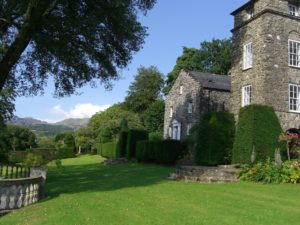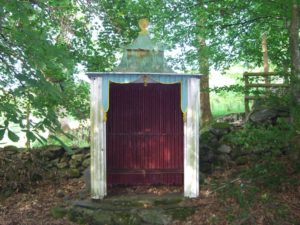10 August 2017
A better Plas
The legacy of Clough Williams-Ellis
by J.R. Thomas

 Clough Williams-Ellis’s career bestrode most the twentieth century.
Clough Williams-Ellis’s career bestrode most the twentieth century.
“Who he?” you may be muttering over the muesli; if and when you do recall who he, you may well smite your forehead and shout “Of course!”
Clough, born in 1883, was by profession and by temperament an architect. At age eighteen he sent himself to the Architectural Association School in London, but finding it was teaching him little (at least about those things which he wanted to know about) he joined a small architectural practice for eight months, after which he sent up his own practice and procured his first commission. He was then twenty.
With interruptions for war service, he practised as an architect for seventy four years until his death in 1978. In the 1920’s he was a prolific and fashionable architect, with a style, whilst derivative of classical Georgian, very much of his own – and still recognisable. He wrote a number of campaigning books about architecture, design, and planning, the best known being “England and the Octopus” published in 1928, which set about ribbon development – those long straggling lines of houses along country lanes and on town outskirts – and was very influential in not only stopping such approaches to building but in the formation of the UK’s planning system. Finally, just to top things off, he was instrumental in the setting up of the National Parks system in the late 1940’s with Sir Arthur Hobhouse.
But those things may not be why you remember him.
Portmeirion. That is why you probably know his name; not the pottery, which was created by his daughter Susan Williams-Ellis, but his extraordinary creation of a complete small town on the north side of Cardigan Bay, a blend of new build and rescued bits of threatened buildings, that piece of Italian Lingurian coastal townscape which has somehow landed in North Wales, that was entirely Clough’s creation and a forthright statement of his philosophy. Don’t just preach what beautiful is, build it; show, don’t just tell. (Also, those of a certain age or disposition will know, the location of that magnificent but perplexing TV series “The Prisoner“, in which Clough, then aged 85, frequently pops up as an extra). Portmeirion is a great tribute to what can be done with enough energy and constant rigorous attention to design.
But Clough did not just create one paradise; he made two. The other is much smaller, much less known, and much more private – but open to the public, none the less. This is Plas Brondanw, an ancient Welsh manor house, standing in Snowdonia, about five miles north of Portmeirion. It had been a Williams property for many centuries, and Clough’s father unexpectedly inherited it at the beginning of the twentieth century. Being a clergyman of fixed habits he had no use for it and passed it on to his son on his 25th birthday. Clough lived there for the rest of his life (and in Hampstead, he liked hills), making a great garden, then extending his architectural reach out to the neighbouring village and hill farms which he owned.
These acres belong still to his descendants (great grandchildren now) who cleave to and preserve the great man’s designs in both spirit and reality. Indeed it is still very obvious where the Williams-Ellis acres begin: spindly sub-Regency ironwork and bright blue and yellow paint adorn the estate buildings, and a positive riot of blue and yellow mark the gates to Plas Brondanw. Pass through the entrance building (containing all essentials of the touristic life, shop, tea room, ticket desk, loos) and arrive in a formal garden running along the hillside. Yet this is a formal garden where the planted bones of formality are so luscious, so verdant, that, like some overfed and over refreshed dowager of certain years, they burst out of all constraints and bloom with almost indecent restraint. That exuberance is not surprising. There can be few better places to make a garden – southwest facing, within reach of the moderating and moist influence of the sea, yet far enough to escape the salt and the gales. Water is supplied by the hills and mountains above, which manage to multi-function by fencing out any nasty icy north easterlies, and also provide a magnificent backdrop to Clough’s creation. Indeed the whole thing is a piece of theatre, perfect for Clough’s theatrical nature, and enhanced by the careful placement of classical statues and stage like spaces. From every point there are magnificent views of Snowdonia (and indeed, Snowdon). There are avenues that lead to more avenues, secret places, an orangery which must be one of the most beautiful buildings in Britain (available for weddings, should any reader have such inclinations), a terrace of worthies, and all linked by that bright blue and yellow paint work on iron and wood. Somehow it is both inspirational and restful.
At the centre, perched on the hillside, is Plas Brondanw itself, from the garden side a four story tower of clear medieval origin; on the entrance side a much more modest manor. In 1951 the house was severely damaged in a fire, which would have been a major setback to most 68 year olds. Not to Clough, who with huge enthusiasm instantly rebuilt it, gently incorporating a little more light through Georgian style windows and improving the internal arrangements.
 But you still have not seen everything. For that you must leave the garden and cross the lane into the woods on the hillside. Here is a much wilder woodland garden, with mysterious paths and glades, but also with Clough pieces to amuse and enlighten. A column with a flaming urn on top recalls the fire that damaged the house; a tin shelter (but what a tin shelter) provides a resting point; and at the high point, a ruined castle with views to mountains and sea (and to Portmeirion). But no ordinary ruined castle.
But you still have not seen everything. For that you must leave the garden and cross the lane into the woods on the hillside. Here is a much wilder woodland garden, with mysterious paths and glades, but also with Clough pieces to amuse and enlighten. A column with a flaming urn on top recalls the fire that damaged the house; a tin shelter (but what a tin shelter) provides a resting point; and at the high point, a ruined castle with views to mountains and sea (and to Portmeirion). But no ordinary ruined castle.
Clough married Annabelle Strachey in 1915, whilst serving as an officer in the Welsh Guards. His fellow officers asked what might constitute a suitable wedding present. “A ruin” said Clough; here it is.
Clough lived to the age of 95, always blessed with good health, fizzing energy, and a mind which was a fountain of ideas which never dried up. He did so much in the wider world, but at the centre of all that was him was Plas Brondanw. He wrote: “It was for Brondanw’s sake that I worked and stinted, for its sake that I chiefly hoped to prosper ” and related how in his early years earnings from commissions were instantly translated to yew hedging or stone paving (later to the purchase of an adjacent mountain) to improve his garden. The greatest gardens are usually the creation of a single great inspired mind and a lot of very hard physical graft. The danger is that they decay when that inspiration is no longer there. Plas Brondanw, safe in a charitable foundation controlled by the Williams-Ellis family, still has much of the fun and drive of its creator. It is a remote place, but well worth the journey to get there.
Plas Brondanw is near Porthmadog in North Wales, a ten minute drive from Portmeirion. It is open every day, 10am to 5pm, (check before travelling in winter)
If you enjoyed this article please share it using the buttons above.
Please click here if you would like a weekly email on publication of the ShawSheet

